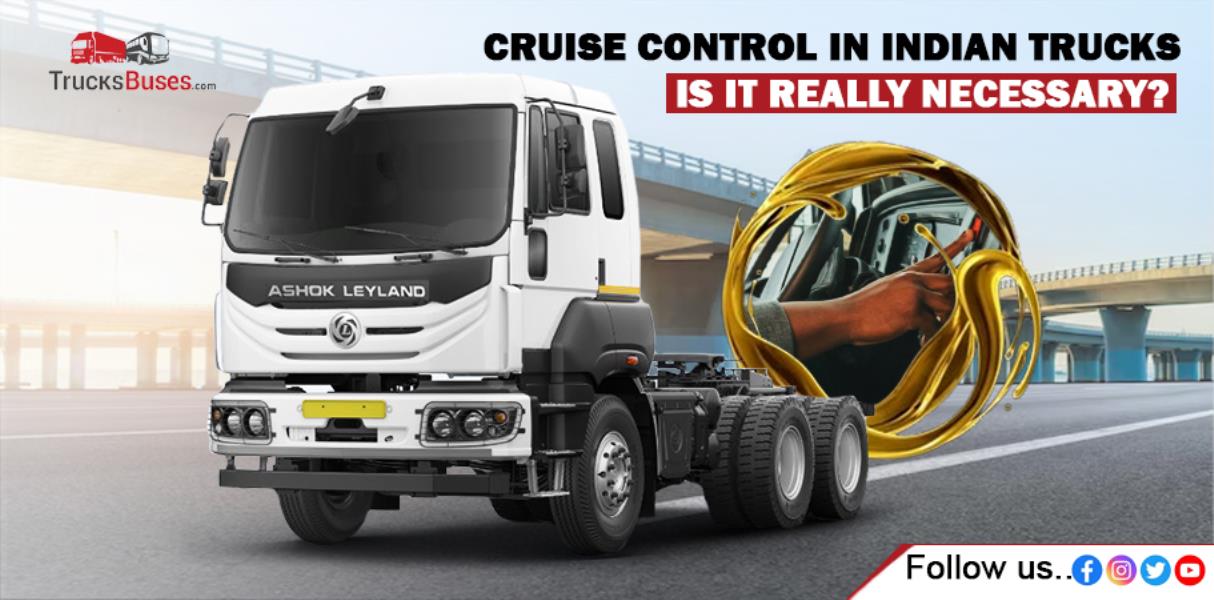Cruise Control in Indian Trucks: Is It Necessary?
In the commercial vehicle sector, technology plays a crucial role in enhancing safety and performance. One such innovation is the cruise control system, which has proven to improve both occupant and cargo safety in trucks. Studies show that about 50 percent of truck accidents are due to speeding, and cruise control can help mitigate this risk. By regulating speed, cruise control aids in reducing accidents and enhancing road safety.

What Is a Cruise Control System in Trucks?
Cruise control is a feature that allows truck drivers to maintain a set speed without continuously pressing the accelerator pedal. This is especially useful on highways, where maintaining a constant speed can enhance driver comfort and performance of the truck. An advanced version, called adaptive cruise control, not only sets a speed but also keeps a safe distance from the vehicle ahead. If the vehicle in front slows down, the adaptive system automatically reduces the truck's speed, making it ideal for heavy traffic conditions.
Why Do You Need to Use a Cruise Control System?
The primary reason for using a cruise control system is safety, but there are additional benefits as well. It can enhance fuel efficiency, reduce operating costs, and improve overall driver productivity. Furthermore, cruise control helps distribute the load evenly, especially beneficial when hauling heavy cargo. Here are some key advantages:
Mileage Enhancement
A cruise control system significantly improves fuel efficiency by maintaining a consistent speed. This reduces the need for constant gear shifts and acceleration, which can drain fuel. A stable pace means better mileage, ultimately saving money for the operator.
Reduction in Fatigue
Driving can be exhausting, particularly when hauling heavy goods. Cruise control allows drivers to take their feet off the accelerator, reducing stress and fatigue. This feature is invaluable during long hauls.
Speed Limits
Avoiding speeding tickets is crucial for truck drivers. With cruise control, drivers can set a speed limit, ensuring they stay within legal boundaries. This not only saves money but also helps maintain a clean driving record.
Improvement in Reaction Time
By easing the workload on the driver, cruise control allows for better focus on the road. This can improve reaction times in unexpected situations, helping to avoid potential accidents.
Predict Turnaround Time
When cruise control maintains a steady speed, drivers can more accurately estimate arrival times. This aids in trip planning and helps fleet managers coordinate schedules effectively.
Improvement in Stability
Heavy loads can shift during acceleration and deceleration, affecting vehicle stability. By maintaining a consistent speed, cruise control helps minimize load shifting, leading to safer driving conditions.
When to Use Cruise Control
Knowing When to Engage Cruise Control
While cruise control has many benefits, drivers must know when it is safe to use. It is not advisable to engage cruise control in bad weather, such as heavy rain or icy conditions, as these can increase the risk of losing control.
Setting the System or Engaging It
To use cruise control, first locate the on/off button. After activating it, accelerate to the desired speed while adhering to speed limits. Once the speed is set, use the designated button to lock it in.
Adjusting the Speed
Cruise control systems typically feature buttons for increasing or decreasing speed without disengaging the system. This allows for gradual adjustments while staying compliant with speed limits.
Turning Off the System
Disengaging cruise control is straightforward. Pressing the brake pedal will automatically turn off the system. Alternatively, you can use the on/off button to deactivate it manually.
Conclusion
A cruise control system is increasingly becoming a necessity for modern trucks. It enhances haulage operations, reduces driver fatigue, and improves fuel efficiency. While it does significantly lower the chances of accidents, it is important to remember that it only controls speed. Active driving remains essential.
Manufacturers should prioritize the installation of cruise control systems in trucks to boost driver comfort, safety, and efficiency. These factors are crucial for enhancing profitability and improving turnaround times in the commercial vehicle industry. With the growing focus on safety and efficiency, cruise control could very well become a standard feature in Indian trucks.
Also Read -
Understanding Engine Oils for Trucks
Understanding Engine Idling